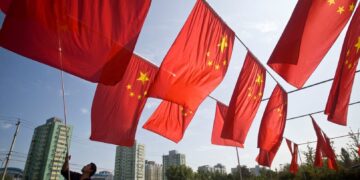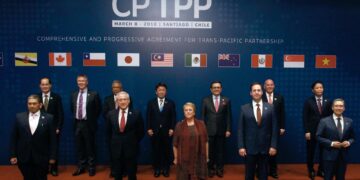With a new headquarters and upbeat sales, Tyco Electronics CEO Thomas Lynch says the future looks bright in China.The global economic downturn has created tough times for many companies. During that time, Tyco Electronics (TE) has been ramping up its China operations.
TE is a leading global provider of engineered electronic components, network solutions, specialty products, and subsea telecom systems. With 150,000 customers in more than 150 countries, the company’s fiscal 2009 sales reached $10.3 billion. TE designs, manufactures, and markets products for customers in a wide range of industries, including the aerospace, auto, data communication and consumer electronics, defense and marine, energy, lighting, medical, and telecom industries.
China accounted for 14 percent of TE’s total revenue in fiscal year 2009 and is one of the company’s top three markets. More than 40 percent of all of TE’s employees globally are based in China.
Thomas J. Lynch, chief executive officer and a member of TE’s Board of Directors, recently discussed the company’s China operations with CBR Editor Paula M. Miller. Lynch joined Tyco International in September 2004 as president of Tyco Engineered Products and Services and was promoted to his current role in January 2006. TE became an independent, publicly traded company in 2007. Lynch also serves on the board of directors of the US-China Business Council, which publishes the CBR.
When and how did TE originally enter China? How big are its operations now?
Lynch: TE has deep roots in China, where we have had a presence for over 22 years. We initially came to China to be close to our customers who had established operations there. We opened our first representative office in Shanghai in 1988, and just a year later, we opened our first mainland China manufacturing site in Shanghai as a joint venture with a local partner. Today, we have two joint ventures—both in Shanghai—and 17 wholly foreign-owned enterprises in China. Going from just a handful of employees in 1988, Tyco Electronics now has 37,000 employees working in China.
How has TE’s business strategy and types of products manufactured or sold there changed over the years?
Lynch: Initially, our business strategy was driven by the need to have facilities close to our customers, who were primarily foreign manufacturers exporting from China. Today we have manufacturing sites in Guangdong, Jiangsu, Shandong, and Shanghai, and 15 sales offices nationwide, with the largest in Beijing, Shanghai, and Guangzhou and Shenzhen, Guangdong.
The big change in the last 10 years has been the emergence of a large local market, including rapidly growing Chinese companies that are now our customers. Today, about one-third of our revenue in China is from local Chinese customers who serve both the local and export markets.
What types of products does TE manufacture in China?
Lynch: The products we manufacture and sell in China include network cabling products that are widely used in enterprise networks, cable accessories and power measurement and control systems for the energy sector, precision-engineered wire and cable solutions used in medical devices, fiber-optic products for the communications industry, touch-screen technology solutions, circuit protection products, and more.
Most of our manufacturing operations in China serve the consumer electronics industry by making various antenna products, sockets, and connectors and relays for use in personal computers, smart phones, digital cameras, and MP3 players.
We have a strong manufacturing base in Suzhou, Jiangsu, which makes auto products that range from sensors and terminals to cable assemblies. It’s likely that every car or truck operating in China includes some components made by Tyco Electronics. One recent product innovation is our Alternative Power System products developed for hybrid/electric cars. We are also one of the first manufacturers to partner with China OEMs [original equipment manufacturers] to pioneer the design of a dual-clutch transmission system.
Our relay manufacturing site in Shenzhen is one of the largest in the world. Products from that factory are used in passenger and commercial vehicles, household appliances, and commercial and industrial equipment worldwide.
TE is also a world leader in touch-screen technology. Over 90 percent of all our touch-screen products are manufactured in China, and we are extremely proud that they have been used in the 2008 Beijing Olympics, the 2010 Winter Olympics in Vancouver, and this year’s world expo in Shanghai (see The World Expo Comes to Shanghai).
What have been TE’s top challenges in China, and what has the company done to overcome them?
Lynch: China is a very exciting and dynamic market. Our challenge, like many companies, is making sure we have the talent in place to cope with the pace of change. Speed is especially critical in China because the markets evolve so quickly. Our approach is to put top leadership in the country and aggressively cultivate local talent, especially in sales, marketing, engineering, and manufacturing.
We have built a strong staffing function in China and are implementing a comprehensive strategy to bring different kinds of local talent into our company. Employees at all levels in the organization participate in various training and development programs as well as rotation opportunities. For example, we have over 4,000 online training courses for employees to improve skills and advance their individual development needs. We introduced tailor-made programs—such as China Engineering Week, product management training, and the Mini-Executive MBA—so that specific talent groups build key competencies and leadership skills.
This year, we also launched a GoChina project to bring global engineering talent to China to collaborate with the local team for the booming auto business. Engineers from Germany and the United States are assigned to China for three months to conduct training, transfer knowledge, and co-manage product development with our local auto engineers.
What are TE’s top successes in China?
Lynch: TE has achieved a great deal in China over the years. China sales in fiscal 2009 reached $1.4 billion. We are also a well-established and respected supplier to China’s auto, communications and energy infrastructure, mobile devices, and appliances industries.
I’m very proud of what our team has achieved in China. Today, one of our key global accounts is a Chinese telecom company that has quickly grown into a global $30 billion business. We’ve been able to work closely with the company to deliver solutions in a few areas, including high-speed signal technology for the next generation system, Fiber & Power to the Antenna [F/P-TTA] solutions, and the new RF [radio frequency] switching solution for the wireless market. It’s been exciting to team with a Chinese company and be a part of its evolution into a global player.
We are also supporting many of our global product families with products that are “Created in China.” For example, antenna technology developed in our Beijing lab is used in mobile computing platforms. Engineers at our Shanghai research and development [R&D] center have designed medium- and high-voltage connectors used in the energy grid. Professionals at our R&D center have also designed a truly innovative edge-mounted junction box for solar panels used in the nascent BIPV [building integrated photovoltaic] market—and this technology was used in some of the major pavilions in the 2010 Shanghai world expo.
Much of our success in China is also based on our ability to draw on the strength of our global operations. For example, our auto business recently worked closely with one of its Chinese OEM customers to solve the customer’s technology and cost challenges. We were able to deliver a solution with help from our engineering teams around the world. When I met with that customer, it was clear that they valued our willingness to partner with them and our ability to marshal resources from all over the world.
As a major manufacturing engine for Tyco Electronics, the 16 manufacturing sites we have in China have been playing a significant role in advancing TE’s overall operational efficiency. In June, our Zhuhai, Guangdong, plant reached the highest operational efficiency of any of the 97 manufacturing sites we operate around the world.
What about some of the successes that don’t necessarily show up on a balance sheet?
Lynch: TE is also committed to being a good corporate citizen and being engaged in the local community. For example, after the 2008 Sichuan earthquake, we donated about $1.9 million to the relief and recovery efforts. This May, we kicked off a volunteer program called “Seeing the Expo from One Meter High,” in which we donated 450 wheelchairs and arranged 150 of our employees to volunteer to help people with difficulties visit the Shanghai expo by wheelchair. We’ll continue to provide this type of local support, because we want to participate and contribute fully in the tremendous growth and development that we see all around us in China.
When will TE open its new China headquarters (HQ) in Shanghai?
Lynch: In October, we will open a new eight-story, 11,800 m2 China HQ building that can house more than 900 employees from several businesses and functional areas. The building will use our own products throughout, demonstrating first-hand how our technology works. It will also feature a product showroom, cafeteria, and gym, and will offer staff training on healthy lifestyle habits. This HQ building is located near our other two Shanghai sites and will raise the number of staff in that city to roughly 3,200. Within this campus, we will have the full range of our operations, including R&D, sales and marketing, management, and manufacturing.
Shanghai is the logical place for the HQ location, not only because it is a focal point of China’s economic, financial, cultural, and educational growth, but also because it is the base for much of our China leadership team and our R&D activities in China. In addition, many of TE’s global and regional leadership are based in Shanghai.
Has the global recession significantly affected TE’s China operations? What do you predict the China market will be like for TE in 5 or 10 years?
Lynch: Last year was challenging for most companies around the world and China’s market was no exception. That was the first year our sales declined in China, so we were faced with new challenges. I’m proud of the way our team navigated through those tough times. There is no doubt in my mind that we came through 2009 a stronger company. Despite the downturn, we still achieved $1.4 billion in revenue in China and strengthened our position with many of our customers there. Our contribution to global sales in 2009 was up 2 percentage points compared with 2008.
Thanks to China’s resilient economy and government stimulus plan, we saw a quick bounce back at the end of 2009, and the trend has been continuing into 2010. Our auto business in particular has been accelerating. This year we expect to book roughly $500 million in revenue supplying the China auto market, which would be a 67 percent jump over last year. China is the world’s largest producer of autos and Tyco Electronics is one of the world’s leading providers of automotive connectivity. We expect that China will continue to be a high-growth market for most of our other products as well for the foreseeable future.
Put simply, success in China is key to Tyco Electronics’ overall success.





























